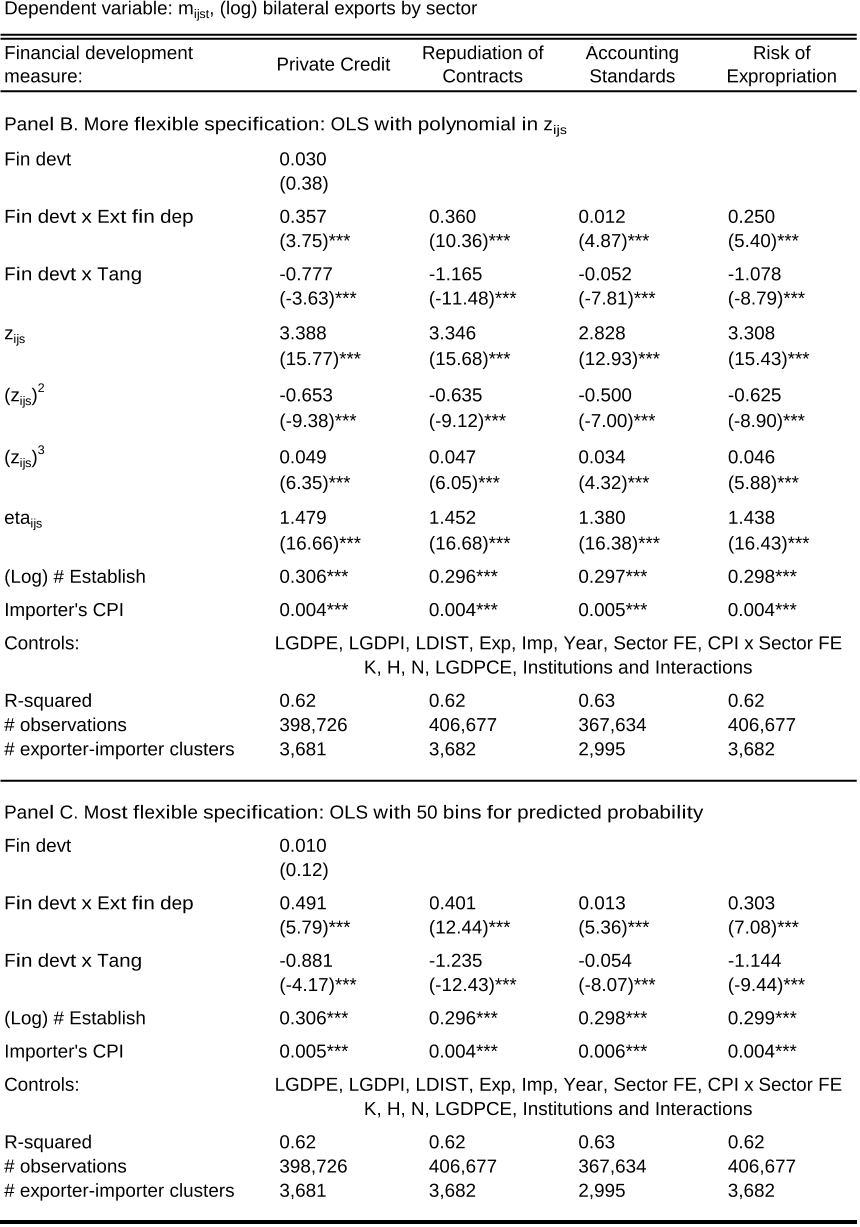Credit Constraints, Heterogeneous Firms and International Trade
Reads0
Chats0
TLDR
This article examined the detrimental consequences of financial market imperfections for international trade and developed a heterogeneous-firm model with countries at different levels of financial development and sectors of varying financial vulnerability.Abstract:
This paper examines the detrimental consequences of financial market imperfections for international trade. I develop a heterogeneous-firm model with countries at different levels of financial development and sectors of varying financial vulnerability. Applying this model to aggregate trade data, I study the mechanisms through which credit constraints operate. First, financial development increases countries' exports above and beyond its impact on overall production. Firm selection into exporting accounts for a third of the trade-specific effect, while two thirds are due to reductions in firm-level exports. Second, financially advanced economies export a wider range of products and their exports experience less product turnover. Finally, while all countries service large destinations, exporters with superior financial institutions have more trading partners and also enter smaller markets. All of these effects are magnified in financially vulnerable sectors. These results have important policy implications for less developed economies that rely on exports for economic growth but suffer from poor financial contractibility.read more
Figures

Table 10. Economic Significance: Predicted vs. Actual Trade Growth 
Table 9. Economic Significance: Comparative Statics 
Table 5. Financial Development and Firm-Level Exports 
Figure 3. The Productivity Cut-off for Exporting 
Table 5. Financial Development and Firm-Level Exports 
Table 1. Export Patterns in the Data
Citations
More filters
Journal ArticleDOI
How Firms Export: Processing vs. Ordinary Trade with Financial Frictions
Kalina Manova,Zhihong Yu +1 more
TL;DR: The authors examined how financial frictions affect companies' choice between processing and ordinary trade, and how this decision affects performance and showed that more profitable trade regimes require more working capital because they entail higher up-front costs.
ReportDOI
Aggregate implications of credit market imperfections
TL;DR: In this article, the same single model of credit market imperfections is used to bring together a diverse set of results within a unified framework, and the authors aim to draw a coherent picture so that one is able to see some close connections between these results, thereby showing how a wide range of aggregate phenomena may be attributed to the common cause.
Posted Content
International trade integration: a disaggregated approach
TL;DR: The authors investigated the sources and size of trade barriers at the industry level and derived a micro-founded measure of industry-specific bilateral trade integration that has an in-built control for time-varying multilateral resistance.
Posted Content
When Is Quality of Financial System a Source of Comparative Advantage
TL;DR: In this paper, the authors unify the two competing schools of thought in a general equilibrium framework and show that there are threshold effects defined by a set of deep institutional parameters (cost of financial intermediation, quality of corporate governance, and level of property rights protection) which can be used to separate economies of high quality institutions from those of low quality institutions.
Journal ArticleDOI
The effects of the financial crisis on Sub-Saharan Africa
TL;DR: In this article, the authors analyse the channels through which the economic and financial crisis of 2008-2009 was transmitted to Sub-Saharan Africa, with a focus on countries in situation of fragility.
References
More filters
Posted Content
Law and Finance
Rafael La Porta,Rafael La Porta,Florencio Lopez de Silanes,Florencio Lopez de Silanes,Andrei Shleifer,Andrei Shleifer,Robert W. Vishny,Robert W. Vishny +7 more
TL;DR: This paper examined legal rules covering protection of corporate shareholders and creditors, the origin of these rules, and the quality of their enforcement in 49 countries and found that common law countries generally have the best, and French civil law countries the worst, legal protections of investors.
Journal ArticleDOI
Law and Finance
TL;DR: In this article, the authors examined legal rules covering protection of corporate shareholders and creditors, the origin of these rules, and the quality of their enforcement in 49 countries and found that common-law countries generally have the strongest, and French civil law countries the weakest, legal protections of investors, with German- and Scandinavian-civil law countries located in the middle.
Journal ArticleDOI
The Impact of Trade on Intra-Industry Reallocations and Aggregate Industry Productivity
TL;DR: This paper developed a dynamic industry model with heterogeneous firms to analyze the intra-industry effects of international trade and showed how the exposure to trade will induce only the more productive firms to enter the export market (while some less productive firms continue to produce only for the domestic market).
Journal ArticleDOI
Finance and Growth: Schumpeter Might Be Right
TL;DR: In this paper, the authors examined a cross-section of about 80 countries for the period 1960-89 and found that various measures of financial development are strongly associated with both current and later rates of economic growth.
ReportDOI
Financial Dependence and Growth
Raghuram G. Rajan,Raghuram G. Rajan,Raghuram G. Rajan,Luigi Zingales,Luigi Zingales,Luigi Zingales +5 more
TL;DR: This paper examined whether financial development facilitates economic growth by scrutinizing one rationale for such a relationship; that financial development reduces the costs of external finance to firms, and found that industrial sectors that are relatively more in need of foreign finance develop disproportionately faster in countries with more developed financial markets.